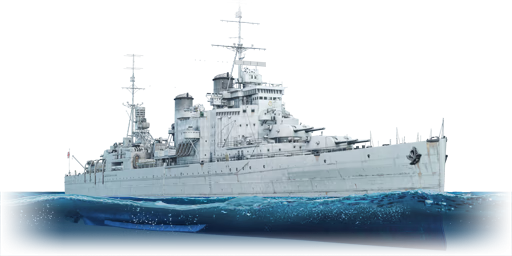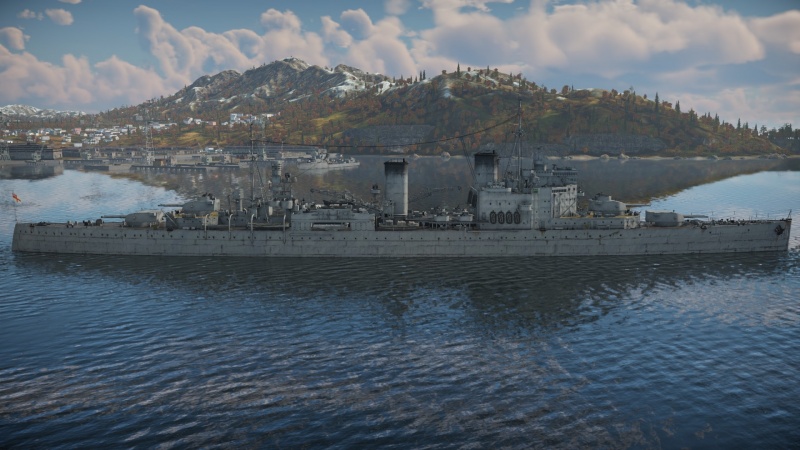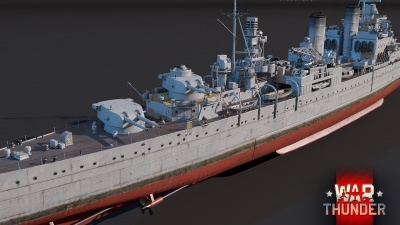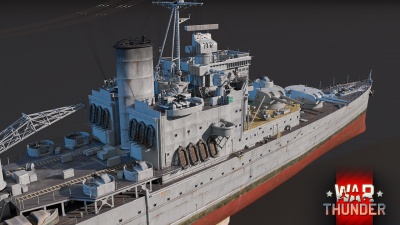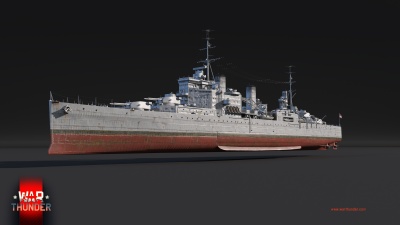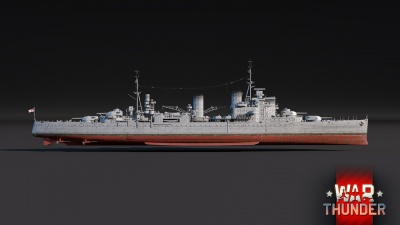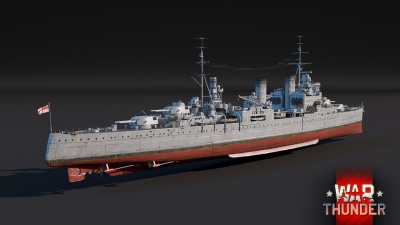Difference between revisions of "HMS London"
(History, text only) (Tag: Visual edit) |
(Reverted edits by User:Monika_in_action) |
||
| Line 70: | Line 70: | ||
* Outgunned by battleships, battlecruisers, and some American heavy cruisers | * Outgunned by battleships, battlecruisers, and some American heavy cruisers | ||
| − | == History ==<!-- ''Describe the history of the creation and combat usage of the ship in more detail than in the introduction. If the historical reference turns out to be too long, take it to a separate article, taking a link to the article about the ship and adding a block "/History" (example: <nowiki>https://wiki.warthunder.com/(Ship-name)/History</nowiki>) and add a link to it here using the <code>main</code> template. Be sure to reference text and sources by using <code><nowiki><ref></ref></nowiki></code>, as well as adding them at the end of the article with <code><nowiki><references /></nowiki></code>. This section may also include the ship's dev blog entry (if applicable) and the in-game encyclopedia description (under <code><nowiki>=== In-game description ===</nowiki></code>, also if applicable).'' --> | + | == History == |
| + | <!-- ''Describe the history of the creation and combat usage of the ship in more detail than in the introduction. If the historical reference turns out to be too long, take it to a separate article, taking a link to the article about the ship and adding a block "/History" (example: <nowiki>https://wiki.warthunder.com/(Ship-name)/History</nowiki>) and add a link to it here using the <code>main</code> template. Be sure to reference text and sources by using <code><nowiki><ref></ref></nowiki></code>, as well as adding them at the end of the article with <code><nowiki><references /></nowiki></code>. This section may also include the ship's dev blog entry (if applicable) and the in-game encyclopedia description (under <code><nowiki>=== In-game description ===</nowiki></code>, also if applicable).'' --> | ||
| + | HMS ''London'' (69) was a second-generation County-class heavy cruiser. Unlike her predecessor, ''[[HMS Kent (54)|HMS Kent]]'', the ''London'' has a revised superstructure and different armour protection. Commissioned in 1929, she saw extensive service before the War including the evacuation of refugees from Barcelona, during the Spanish Civil War. She was the only County-class heavy cruiser to be reconstructed, and featured a superstructure similar to the ''Fiji''-class cruisers. During the Second World War, she participated in the hunt for ''Bismarck'' but spent most of her time serving with the Eastern fleet. She served with the China Station after the end of the war, and was scrapped in 1950. | ||
| − | + | '''Design and construction''' | |
| − | |||
| − | The | + | The ''London'', similar to her predecessors, was designed as a treaty cruiser of the Washington Naval Treaty. Thus, she was built within the 10-thousand ton standard-displacement limit and suffered, subsequently, from having little armour. She carried substantial armament of eight 8-inch (203 mm) guns in four double mounts, as well as two quadruple torpedo launchers.<ref name=":0">Chen, C. (2007)</ref> She was also one of the only County-class ships to receive an improved anti-aircraft armament. She could make a top speed of 31 knots (57 km/h).<ref name=":0" /> |
| − | + | The ''London'' was laid down in February of 1926, and was launched in September of 1927. She was formally commissioned on January 31st 1929.<ref name=":0" /><ref name=":1">Helgason, G. (1995)</ref> | |
| − | |||
| − | + | '''Operational service''' | |
| − | + | After her commissioning, the ''London'' became the flagship of the 1st Cruiser squadron. She served with the 1st Cruiser squadron until the outbreak of war in 1939. During the Spanish Civil War, ''London'' evacuated thousands of civilians from Barcelona with her sister ship ''Shropshire''. From March 1939, she was given a lengthy refit; though her engines were not refitted, she was given a new superstructure giving her a similar appearance to the ''Fiji''-class cruisers.<ref name=":1" /> | |
| − | + | ''London's'' reconstruction was completed by March of 1941; she then participated in the hunt for the German battleship ''Bismarck''.<ref name=":0" /> During this time, it was found that her new superstructure caused significant weight stress to the upper hull, so she was repaired once again between late 1941 and early 1942.<ref name=":1" /> When service with the British Atlantic fleet caused cracks to appear in the hull, she was repaired once again; this time, she would not be operational until 1943. Following the completion of repairs, she served with the Eastern fleet until the end of the war.<ref name=":1" /> | |
| − | As | + | As the only modernised County-class heavy cruiser, the ''London'' was selected to serve after the war. She sailed to the Far East in 1946 to serve with the China Station. She remained in Chinese waters until 1949, when she was relieved by the cruiser HMS ''Kenya''.<ref name=":1" /> It was determined that London's ageing equipment and large crew complement made an additional refit unfeasible; as a result, she was sold for scrapping in 1950.<ref name=":1" /> |
| − | |||
| − | |||
| − | |||
| − | |||
| − | |||
| − | |||
| − | |||
| − | |||
=== [[wt:en/news/6626-development-hms-london-anticipated-calibre-en|Devblog]] === | === [[wt:en/news/6626-development-hms-london-anticipated-calibre-en|Devblog]] === | ||
| Line 133: | Line 125: | ||
=== Works Cited === | === Works Cited === | ||
| − | * | + | * Chen, C. (2007, May). Heavy Cruiser London. Retrieved November 17, 2020, from <nowiki>https://ww2db.com/ship_spec.php?ship_id=326</nowiki> |
| − | * | + | * Helgason, G. (1995). HMS London (69). Retrieved November 17, 2020, from <nowiki>https://uboat.net/allies/warships/ship/1178.html</nowiki> |
| − | |||
| − | |||
| − | |||
{{Britain heavy cruisers}} | {{Britain heavy cruisers}} | ||
Revision as of 11:42, 20 May 2021
Contents
Description
The County-class, HMS London (69), 1945 is a rank IV British heavy cruiser with a battle rating of 5.7 (AB/RB/SB). It was introduced in Update 1.97 "Viking Fury".
General info
Survivability and armour
Talk about the vehicle's armour. Note the most well-defended and most vulnerable zones, e.g. the ammo magazine. Evaluate the composition of components and assemblies responsible for movement and manoeuvrability. Evaluate the survivability of the primary and secondary armaments separately. Don't forget to mention the size of the crew, which plays an important role in fleet mechanics. Save tips on preserving survivability for the "Usage in battles" section. If necessary, use a graphical template to show the most well-protected or most vulnerable points in the armour.
Mobility
Write about the ship's mobility. Evaluate its power and manoeuvrability, rudder rerouting speed, stopping speed at full tilt, with its maximum forward and reverse speed.
| Mobility Characteristics | |||
|---|---|---|---|
| Game Mode | Upgrade Status | Maximum Speed (km/h) | |
| Forward | Reverse | ||
| AB | |||
| Upgraded | 70 | 29 | |
| RB/SB | |||
| Upgraded | 60 | 25 | |
Modifications and economy
Armament
Primary armament
Provide information about the characteristics of the primary armament. Evaluate their efficacy in battle based on their reload speed, ballistics and the capacity of their shells. Add a link to the main article about the weapon: {{main|Weapon name (calibre)}}. Broadly describe the ammunition available for the primary armament, and provide recommendations on how to use it and which ammunition to choose.
Secondary armament
Some ships are fitted with weapons of various calibres. Secondary armaments are defined as weapons chosen with the control Select secondary weapon. Evaluate the secondary armaments and give advice on how to use them. Describe the ammunition available for the secondary armament. Provide recommendations on how to use them and which ammunition to choose. Remember that any anti-air armament, even heavy calibre weapons, belong in the next section. If there is no secondary armament, remove this section.
Anti-aircraft armament
An important part of the ship's armament responsible for air defence. Anti-aircraft armament is defined by the weapon chosen with the control Select anti-aircraft weapons. Talk about the ship's anti-air cannons and machine guns, the number of guns and their positions, their effective range, and about their overall effectiveness – including against surface targets. If there are no anti-aircraft armaments, remove this section.
Additional armament
Describe the available additional armaments of the ship: depth charges, mines, torpedoes. Talk about their positions, available ammunition and launch features such as dead zones of torpedoes. If there is no additional armament, remove this section.
Usage in battles
Describe the technique of using this ship, the characteristics of her use in a team and tips on strategy. Abstain from writing an entire guide – don't try to provide a single point of view, but give the reader food for thought. Talk about the most dangerous opponents for this vehicle and provide recommendations on fighting them. If necessary, note the specifics of playing with this vehicle in various modes (AB, RB, SB).
Pros and cons
Pros:
- Very effective anti-air defences
- 8 inch guns are useful for sinking cruisers and destroyers
- Ammunition is stored under the water line and is well protected
- Carries torpedoes which are useful in close range encounters
- Decent speed for a heavy cruiser
Cons:
- Guns lack AP shells to deal with battlecruisers and battleships
- No bridge protection, losing control is very common in this ship
- Lacks deck armour against plunging shells
- Armour is weak against battleship-calibre guns
- Outgunned by battleships, battlecruisers, and some American heavy cruisers
History
HMS London (69) was a second-generation County-class heavy cruiser. Unlike her predecessor, HMS Kent, the London has a revised superstructure and different armour protection. Commissioned in 1929, she saw extensive service before the War including the evacuation of refugees from Barcelona, during the Spanish Civil War. She was the only County-class heavy cruiser to be reconstructed, and featured a superstructure similar to the Fiji-class cruisers. During the Second World War, she participated in the hunt for Bismarck but spent most of her time serving with the Eastern fleet. She served with the China Station after the end of the war, and was scrapped in 1950.
Design and construction
The London, similar to her predecessors, was designed as a treaty cruiser of the Washington Naval Treaty. Thus, she was built within the 10-thousand ton standard-displacement limit and suffered, subsequently, from having little armour. She carried substantial armament of eight 8-inch (203 mm) guns in four double mounts, as well as two quadruple torpedo launchers.[1] She was also one of the only County-class ships to receive an improved anti-aircraft armament. She could make a top speed of 31 knots (57 km/h).[1]
The London was laid down in February of 1926, and was launched in September of 1927. She was formally commissioned on January 31st 1929.[1][2]
Operational service
After her commissioning, the London became the flagship of the 1st Cruiser squadron. She served with the 1st Cruiser squadron until the outbreak of war in 1939. During the Spanish Civil War, London evacuated thousands of civilians from Barcelona with her sister ship Shropshire. From March 1939, she was given a lengthy refit; though her engines were not refitted, she was given a new superstructure giving her a similar appearance to the Fiji-class cruisers.[2]
London's reconstruction was completed by March of 1941; she then participated in the hunt for the German battleship Bismarck.[1] During this time, it was found that her new superstructure caused significant weight stress to the upper hull, so she was repaired once again between late 1941 and early 1942.[2] When service with the British Atlantic fleet caused cracks to appear in the hull, she was repaired once again; this time, she would not be operational until 1943. Following the completion of repairs, she served with the Eastern fleet until the end of the war.[2]
As the only modernised County-class heavy cruiser, the London was selected to serve after the war. She sailed to the Far East in 1946 to serve with the China Station. She remained in Chinese waters until 1949, when she was relieved by the cruiser HMS Kenya.[2] It was determined that London's ageing equipment and large crew complement made an additional refit unfeasible; as a result, she was sold for scrapping in 1950.[2]
Devblog
The County-class cruisers, also known as the A-Type cruisers, were the first British cruiser vessels to be developed in the interwar period of the 1920s. Their design being heavily influenced by the restrictions imposed by the Washington Naval Treaty, meant that British shipbuilders had to find compromises during development in order to comply with the treaty as well as to meet the requirements of the Royal Navy for a ship capable of trade route protection.
This resulted in the creation of a ship design with good cruising range and adequate firepower, but very light armour protection in order to stay within treaty restrictions. The orders for the first ships were placed in the mid 1920’s and construction began in 1924.
HMS London (C69) was laid down in February 1926 and commissioned into service in January 1929 as the lead ship of the second batch of County-class cruisers to be built, known as the London subclass. During the 1930’s, HMS London took part in a goodwill visit to Venice and assisted in the evacuation of civilians from Barcelona during the Spanish Civil War, before being sent to drydock for refit in 1939.
In 1941, HMS London took part in the hunt for the battleship Bismarck, after which the ship was once again dry-docked for repairs. The following year, HMS London assisted in escorting several convoys in the Atlantic, after which she was assigned to South African waters in 1943, before joining the Eastern Fleet. HMS London continued serving in the postwar years, during which the ship got involved in an incident in Chinese waters in 1949 which left it heavily damaged. Being deemed uneconomical for repairs, HMS London was sold for scrap in January 1950.
Media
See also
Links to articles on the War Thunder Wiki that you think will be useful for the reader, for example:
- reference to the series of the ship;
- links to approximate analogues of other nations and research trees.
External links
References
Works Cited
- Chen, C. (2007, May). Heavy Cruiser London. Retrieved November 17, 2020, from https://ww2db.com/ship_spec.php?ship_id=326
- Helgason, G. (1995). HMS London (69). Retrieved November 17, 2020, from https://uboat.net/allies/warships/ship/1178.html
| Britain heavy cruisers | |
|---|---|
| Hawkins-class | HMS Hawkins |
| York-class | HMS York |
| County-class | HMS Kent · HMS London · HMS Norfolk |


